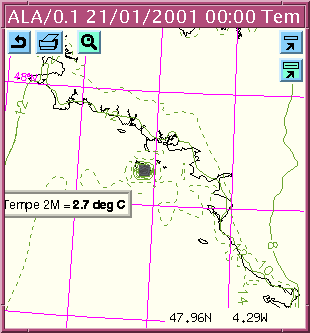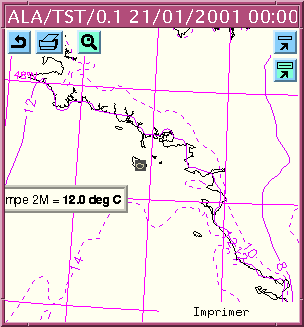

ALADIN runs operationally on a wide range of computers, from single workstations to vectorial computers in shared or distributed memory, and on a cluster of workstations under Linux. 12 operational ALADIN suites are presently running in various NMS. 7 coupling domains are produced operationally at Météo-France, 1 in Prague.
See updated informations on this web server at : http://www.cnrm.meteo.fr/aladin/oper/oper.html .
Implementation of MANDALAY
In order to be able to use DIAGPACK for analyzing surface parameters like surface pressure, wind, visibility, precipitations, ..., the tool MANDALAY was installed at ZAMG as the first step for implementing DIAGPACK. Some technical investigations on the adaptation of data from the ZAMG database to the data format needed by MANDALAY were also done.
Implementation of 500 hPa geopotential verification of ALADIN
A 500 hPa geopotential verification routine for ALADIN-VIENNA was developed. This routine calculates bias, mean absolute error, rms error, standard deviation, and anomaly correlation for the 500 hPa geopotential each day. The verification procedure will be used for monitoring purposes, e.g. when the model cycle is changed.
Main operational work :
Development
Last news in Newsletter16.
The 3rd quarter of the year has been devoted to the organization and preparation of the pre-operational version of ALADIN-HRVATSKA. Preparation steps:
We would like to thank our Slovenian colleagues Neva Pristov and Jure Jerman for help and support.
The last upgrade performed on SYNERGIE server has been done last year. It is
now possible to look at ALADIN-France test suite as well as the ARPEGE one.
This tool is helpful to validate the behavior of any new scheme, in particular
for all the features not controlled by classical scores. For instance, the
present test suite is about modifications on CYCORA physics for both ARPEGE
and ALADIN, and a slight increase of horizontal resolution for ALADIN-France
(9.9 to 9.5km in grid point). The impact on surface temperature of the new
resolution is quite visible on this pictures (figure 1), directly printed from
SYNERGIE. The Belle-Ile temperature is much better now. The problem here was
similar to that encountered on Lake Balaton (paper of S. Kertesz in the last
Newsletter). The island was ignored by the model but present on the finer
post-processing grid. The increase in the model resolution solved the problem
here.
ALADIN-France e-suite on SYNERGIE display


Figure 1: ALADIN-France 2m temperature forecasts, operational (left) and
test (right) suite as seen with SYNERGIE software.
Last news in Newsletter18.
During the period several tools were adapted and installed in Budapest, which
on the one hand helps on the development work and on the other hand extends
the available products based on the ALADIN model. The following tools were
adapted (the work had been started during the stay of Neva Pristov in Budapest):
During the last quarter of 2000 the following main activities were performed around the workstation version of ALADIN:
The new operational suite of ALADIN/LACE based on SMS (Scheduler-Monitor-Supervisor tool ©ECMWF) started on:
After quite a complex testing, the technical organization of the operational suite was completely changed. The suite is now handled by SMS running on a SUN server. The advantages of this technical change are the following:
The operational switch went smoothly. The blending modules are ready by now and may be activated whenever needed.
The Prague Team launched the following parallel tests to assess the impact of different modifications:
The situation with archive server has been treated together by CHMI and by the
provider. It was an interesting lesson: when a bug appears in ARPEGE/ALADIN it
is quite quickly fixed, unlike in case of some software companies which are
not able within two years to provide a stable version of the software they
have charged money for. The new archiving server is now under testing.
Two new parallel tests were started on December 1st. Meanwhile the parallel
test plan was redefined, mainly due to the evolution of ARPEGE parallel test.
The results of parallel tests may be consulted on www.chmi.cz/meteo/ov/lace/aladin_lace/partests/ pages.
Since last year autumn Prague center has got a task to ensure the initial and lateral boundary conditions for all ALADIN applications in case of some major accident in Toulouse. This task resumes to receive a pre-processed observation data file from ECMWF, to run ARPEGE 3DVAR assimilation cycle (4 long cut-off times), to make ARPEGE production forecast up to 60 hours (due to 12h lagged coupling in some ALADIN applications) based on the short cut-off analysis (twice a day) and finally to compute all the LBC files for all ALADIN domains not forgetting to run the LACE suite behind all this. It can be easily understood that all the above mentioned pieces needed a lot of preparation, starting from small details such as verifying all national e-927 namelists and climatological files and ending with more tricky problems on how to properly vectorise and multitask the Canari configuration using the Japanese way of tasks numbering. Though the Prague Team has been more or less continuously working on the issue, November strike-menacing events in Lautrec came something like one week too early (or too late) to get combined with a long weekend (of course!) due to the celebration of the victorious fight for democracy in the country of Vaclav, following thus Murphy's law ""à la lettre"". Despite the enormous efforts the Prague Team managed to run safely under SMS just the long cut-off ARPEGE assimilation cycle before the above mentioned long weekend and happily enough the real intervention of Prague was not needed before the weekend got over. The remaining suite pieces were fixed the following Monday and the vitality of ARPEGE back-up was proved (in terms of still useful timeliness of ALADIN forecasts as also confirmed by SELAM colleagues). The event, ended by corks flying in RC LACE chiefs' office, was quite an useful exercise for the Prague Team to lively experience the pressure of having to handle an operational suite of data assimilation (yet just technically and without a real worry about the observation pre-processing). To say the truth, the ARPEGE back-up suite is never going to be a story of a simple "pressing of the button", for example the supply by the observations from the whole of globe is still quite a vulnerable point.
Since July 2000, Aladin/Morocco is running Canari analysis part using AL11T2 (CY21T2) version. The forecast part has been performed with AL11T2 since February 2000.
This new Upgrade was possible after the tuning of CANARI structure functions for both altitude and surface parameters in the assimilation mode.
The validation has been done on a 10 days parallel suite; and the results obtained with this new version affected especially the surface fields analysis. Altitudes fields still have the same behaviour. A report of this work has been written and is present at GMAP.
So, for the time being, Aladin/Morocco is operational with AL11T2 in both assimilation and forecast modes.
The parallel version of Aladin has been tested on CRAY J90 plate-forme using either PVM and MPICH ; this tests were successful with use of PVM, but the mode LMESSP=.TRUE and NPROCA=4 is very expensive in terme of memory and CPU time compared to the operational mode LMLTSK=.TRUE. and NTASKS=4.
Finally, MAROC-METEO decided last November to buy a new computation machine, an IBM Super Scalar POWER III machine, a shared memory one with 48 GFLOPS of power (32 procs).
Now we plan to run Aladin/Morocco with less than 10km resolution for 60 hours forecast range twice a day. All our futur efforts will then focus on implementing a 3DVAR assimilation suite.
In the second half of 2000 most efforts made by Cracow Aladin team focused on
shifting the operational work from IBM RS/6000 to SGI 2800 machines. New, much
more enhanced model environment was prepared to reach the aim. Here are some
details of current operational suite:
Some other efforts focused on the creation of preliminary versions of two new systems. First one is designed for NWP data storage and access: operational database was built on a basis of RDBMS PostgreSQL and datastored in it are made available via HTML/PHP3 pages. The second system is devoted for qualified forecast preparation support and it is also based on WWW technology: forecaster can get numerical prediction data for given locations placed in interactive form, data can be modified and then preparation of some forecast products can be initialized.
The e923 configuration was implemented on workstation with operational ALADIN cycle (AL11T2) following N. Pristov documentation. We are now testing the two cost functions - Jercynzsky (LNEWORO2 = T) and Bouteloup (LNEWORO = T ) - in order to verify which one represents better the orography of ALADIN/Portugal domain.
In order to run OI/CANARI with local observations some steps have already be done:
Last news in Newsletter18.
DEC Alpha Xp1000 (Compaq), EV6 processor DIGITAL UNIX V4.OD
Digital F90 compiler 640 MB memory
12 GB HDD
domain size 826 x 646 km (120 x 90 points)
corners 14.69, 46.05 SW 25.26, 51.07 NE
horizontal resolution 7.18 km
vertical resolution 31 levels
time step 337.5 s
forecast length 48 hours / twice per day (00 UTC & 12 UTC)
coupling model ALADIN/LACE (12.2 km horizontal resolution)
mode dynamical adaptation
dynamics and physics the same as ALADIN/LACE
ee927 creation of initial and lateral boundary conditions
e001 model forecast
postprocessing on model levels & standard isobaric levels
e701 CANARI (optimal interpolation) recently ported
surface parameters in map form (2m temperature, 2m Tmax, 2m Tmin,
2m relative humidity, l0 m wind, precipitation, cloudiness)
meteograms for 22 cities over Slovakia
input for vertical cross-sections
inputs for the Nuclear Safety Authority (RODOS program)
generation of the automatic forecasts
for central forecasting office, Internet and Intranet
using NCAR graphics, GMT software, HTML
surface parameters of ALADIN/LACE and ALADIN/SLOK forecasts verified
against SYNOP observations over the territory of SLOVAKIA
pseudoTEMP messages verified against TEMP observations
24 total precipitation verified against the local rainguage network
Main news
- size of the domain increased (90x64 = 120x90)
- horizontal and vertical resolution kept
- 2m temperature, l0m wind speed and wind direction
- last 2 runs of ALADIN/LACE and ALADIN/SLOK compared to actual SYNOP observations
- comparison of ALADIN/LACE and ALADIN/SLOK against our rainguage network
observations (600 stations) - data interpolated into common grid
- 24h total amounts used
- contingency tables and continuous scores calculated - evaluation monthly
with 3 months delay
- software ready to be used routinely at SHMI
- comparison of pseudoTEMP forecast
- with CYCORA: warmer and drier planetary boundary layer, increased wind speed
- inputs from ALADIN/LACE and ALADIN/SLOK for the RODOS program (Nuclear
Safety Authority)
Last news in Newsletter16 .
 |
Home |